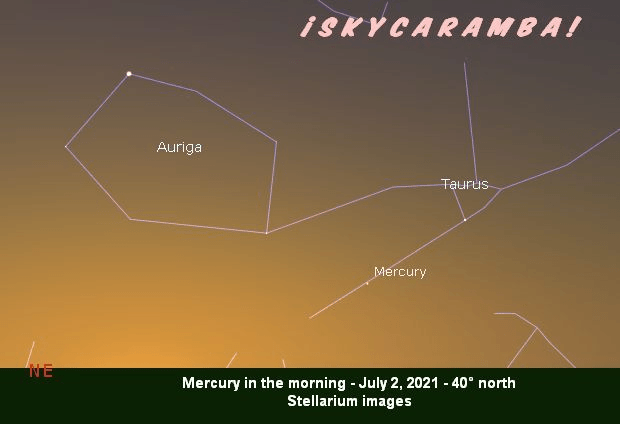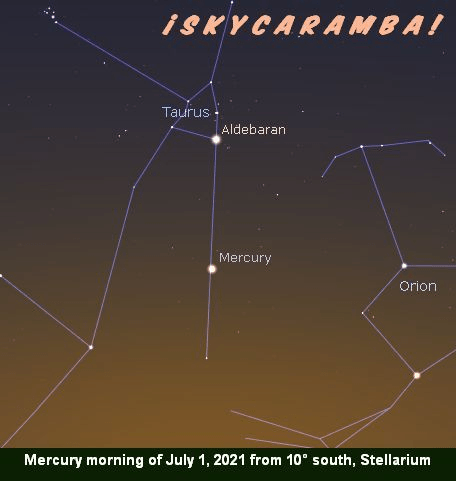


Mars and Venus straddle Cancer on the evening of June 30 as July is about to begin. Both are moving eastward. Venus moves through the Beehive Cluster or M44 the evening of July 3rd. The chase is on. Venus appears to be swooping in for a quick meetup with Mars. As the planets come close, a thin crescent moon is right of them on the 11th. The moon is above them when the planets are at their closest on the 12th and 13th. And then Venus keeps going, passing by Regulus in Leo on the 14th. Mars passes the bright star on the 29th. By that time, Venus is moving on past the lion. The best view of this sight is from low latitudes. Northern hemisphere viewers from middle and high latitudes will find the planets very low as darkness begins.

Saturn is a late evening riser. So is Jupiter a little while after the ringed planet. Both are retrograde this month. A full moon passes south of Saturn on the 24th and 25th. It’s close to Jupiter on the 26th. Saturn stays in Capricornus and Jupiter in Aquarius all month.

As dawn’s light begins, the side of the Hyades V with Aldebaran does a good job pointing the way to Mercury rising. Mercury’s moving eastward, but is becoming easier to spot as the month goes on because of later sunrises for northern hemisphere sky watchers. A thin, waning crescent moon is left of the planet on the 8th. The messenger planet is at the feet of Gemini by mid-July. The planet is disappearing into the morning sun glow as it approaches the Castor side of the constellation. The best views of Mercury this month are from low southern latitudes, although the twins are upside down and their heads below the horizon while Mercury’s still viewable in the twilight.

The moon is crossing the equator going north on the 1st when it’s at last quarter. Northern lunistice is on the 9th at 25.6°. The moon is new the next day. The moon goes south of the equator on the 16th and is at first quarter on the 17th. Southern lunistice is at 25.6° on the 22nd. The moon’s full on the 24th. A second northward equatorial crossing is on the 29th. And a second last quarter moon occurs on the 31st.
The moon’s at apogee on the 5th at 405,300 km. It’s at perigee on the 21st at 364,600 km.
Earth is at aphelion on the 5th at 1.017 astronomical units. Mars is at aphelion on the 13th at 1.666 AU. Mercury is at perihelion on the 24th at 0.307 AU.

Two meteor showers peak on July 30th. And this year, our two naked eye gas giant planets provide some help telling which meteors are from which shower. Meteors from the Southern Delta Aquariid shower radiate from a spot just a little southeast of where Jupiter is lately. And the Alpha Capricornids radiate from a spot a little northeast of where Saturn’s hanging out. It’s hard to know which meteors you’re most likely to see. The Southern Delta Aquariids peak at about 16 meteors per hour. There may only be five Alpha Capricornids per hour, but they’re more likely to be bright fireballs. And with the moon just a few days past full, the brighter the better.
